Op-Ed: The warming may be global, but adaptation will need to be local

- Share via
It’s been three decades since Dr. James Hansen told the Senate Energy and Natural Resources Committee “with 99% confidence” that the Earth was getting warmer, that this “real warming trend” could be linked to the greenhouse effect, and that we could expect more “extreme events” in our weather.
That was in 1988. It’s now 2018, and we still haven’t fully addressed the many ways we’re altering our climate.
A scientific report released Friday by 13 federal agencies warned that climate change could eliminate 10% of the American economy by the end of this century if significant steps aren’t taken to curb greenhouse gas emissions.
There’s evidence that most people in this country want swift action. A recent survey by ABC News, Stanford University and the nonprofit Resources for the Future shows that 61% of Americans want Washington to be doing “a great deal” or “a lot” about global warming, and that 53% favor immediate action over further study.
When it comes to adaptation, we can’t wait for a top-down solution.
What Washington chooses to do is only one part of the equation, however. More and more, people concerned with climate change are plagued by a seemingly simple question: What can I do?
I found the beginnings of an answer on the rugged coast of southeast Alaska, where over a period of five years I studied how global warming is affecting forests there, as well as how the local Alaskans are adapting to their changing environment.
There were a variety of both effects and responses, of course. But there was a clear takeaway that those of us in warmer latitudes would be wise to take to heart: The warming may be global, but adaption will need to be local.
From roughly 2010 to 2015, my colleagues and I watched carefully as forests in the Alexander Archipelago underwent changes caused by global warming. Our research focused primarily on protected lands in four inlets: Slocum Arm, Klag Bay, Dick’s Arm and Graves Harbor.
In vegetation surveys conducted regularly at 50 plots, we observed a host of effects. For instance, many of the forests transitioned from being dominated by the Alaska yellow cedar, a conifer whose shallow roots need snow for insulation from the cold, to being dominated by the western hemlock. This transition was also associated with other changes in the surrounding plant community. Mosses and other bryophytes — land plants that are nonvascular and seedless — became less abundant, for example, while grasses and shrubs became more abundant.
I took thousands of measurements of trees with my team. But I also conducted scores of interviews with locals, hoping to understand how they were grappling with the changes to their landscape. Here, too, we found a host of effects.
Some locals were looking for ways to benefit from the changes. For instance, they were finding new uses for the dead trees and taking advantage of easier hunting conditions in areas affected by dieback.
Some were adapting in other ways. A number of forest managers were altering their management practices, for example. They were experimenting by planting certain species in places where they were more likely to survive, protecting individual trees by insulating their roots from sudden temperature changes and, in some instances, substituting the use of one species for another.
As one might expect, there was a strong correlation between knowledge about climate change and the motivation and ability to adapt. Knowing that the dying trees were linked to climate change led to different adaptive responses. Those who were most connected to nature and knowledgeable about the effects of warming were the most prepared.
Enter the Fray: First takes on the news of the minute from L.A. Times Opinion »
People who had made the connection between the dying trees and climate change were also the ones to report behavioral changes targeted at the global nature of the problem. In addition to grappling with the local consequences, they chose to educate others about climate change by using their local trees as an example. They were also adopting new transportation methods to reduce their energy consumption, such as biking to work.
For those who had made the connection, there was also a strong psychological component to adaptation. This often began with grief over the loss of a tree species and connecting with other people who were affected by the same losses. In particular, people needed to find a way to cope with the understanding that the local changes were spurred by a seemingly uncontrollable, global driver.
Although climate change will affect every continent, every coast, every mountain range differently, the Alaskans who are already coping with its many impacts offer a glimpse into all of our futures. When it comes to adaptation, we can’t wait for a top-down solution.
We know what needs to happen at the global scale: We need to curb emissions.
But as more of us are beginning to learn every year, from the extensive coral bleaching in Australia’s Great Barrier Reef to the massive wildfires that have been ravaging California, climate change will inevitably hit home for all of us.
Lauren E. Oakes is a conservation scientist at the Wildlife Conservation Society, an adjunct professor in the Department of Earth System Science at Stanford University and the author of “In Search of the Canary Tree: The Story of a Scientist, a Cypress, and a Changing World.”
Follow the Opinion section on Twitter @latimesopinion or Facebook
More to Read
A cure for the common opinion
Get thought-provoking perspectives with our weekly newsletter.
You may occasionally receive promotional content from the Los Angeles Times.






